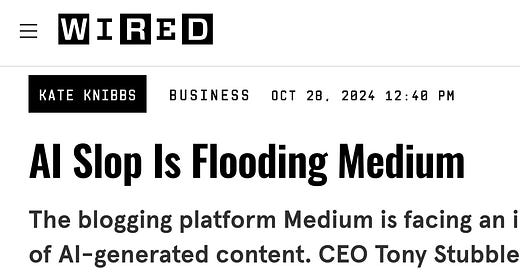With the rise of ChatGPT, AI-generated content has become widespread across the internet, significantly impacting blogging platforms, especially Medium.

To illustrate this, here’s an example: the following article was created by ChatGPT in response to the request, “Write an 800-word article: ‘How to Succeed Software Hustle.’”
At first glance, the content seems OK, doesn’t it?
However, its value is inherently limited (that’s why it is called Slop) because this content is generic and accessible to everyone. True success lies in standing out from the crowd. Successful individuals often have mentors who provide genuine wisdom gained through real-world experience, with stories.
From another perspective, a child could produce dozens of articles like the above daily using ChatGPT. This has significantly saturated the writing market.
How Does AI Slop Affect Medium Writers?
The writing platforms have to deal with AI writing. Medium, the largest one, dealt with it poorly. Its changes to the “Partner Program", introduced in August 2023, drove many good writers off - including me. There are plenty of posts and videos talking about it.
In a recent webinar, Tim Denning (a well-known blogger) in the opening remarks: “Medium is dead. Nobody earns (real) money on Medium now. If you want $20 a month, you may still …”. Please keep in mind that Tim Denning and Todd Brison saying this was to promote their courses. Still, a famous blogger, with 327K followers on Medium, shared a strong opinion about (new) Medium.
I can only speak from my own experience as a technical blog writer. Here, I’ll openly share some of my stats, and you can make your own judgment.
The article, “Correcting Wrong “Playwright’s Advantage over Selenium” Part 1: “Playwright is Modern and Faster than Selenium” (Substack version), is one of my four “Medium Boosted” pieces.
A "Medium Boosted" article is considered high-quality by Medium curators, promoted to a wide audience, and earns about four times more per read. According to a Medium newsletter, only the top ~0.3% of articles receive this distinction.
The total earnings for this article (2024-01 to 2024-11) is $195.
The first month’s earnings (7 days, actually): $42
The 11th month’s earnings: $2.79
Mind you, this is a “Boosted” article, with privileges and much higher earning distribution.
This article is the first in an 11-part series. Getting “boosted” surely is a fantastic start, and it can benefit the other articles in the series. However, the lifetime earnings of the other 10 articles range from just $6.52 to $0.84, with a noticeable downward trend.
I have around 6,000 followers on Medium and have been consistently publishing an average of 2.5 high-quality articles per week for nearly four years. These articles, many of which have been featured in software testing newsletters (154), include four "Medium Boosted" pieces.
Overall, despite producing more new content over the past year, both the reads and my Medium earnings (from new and old posts) have steadily declined, now down to just 30% of what they once were. My previously high-quality articles rarely contribute to earnings anymore. Considering that I once enjoyed a strong growth trend in reads, earnings, and referrals, the situation is actually far worse than a 70% drop—at least for me.

Some influencers might say, “The new Medium Partner Program is great; I’m getting more reads and earning more.” That might be true, but it’s likely the case for bloggers focused on popular topics like health, travel, or get-rich-quick content. Medium’s new distribution algorithm seems to favour these niches, at the expense of many others. I speak from my own experience as a technical blogger.
It’s worth noting that there are suggestions to adapt to the new Medium by altering writing styles—such as creating shorter articles, avoiding links, and so on. However, I haven’t changed my writing style at all in an attempt to boost earnings.
This highlights the current state of writing (for tech writers) on Medium, which is one of the key reasons I decided to switch to Substack.
Of course, Substack isn’t entirely immune to the impact of AI-generated content, but in my opinion, the effect will be less significant compared to Medium. The reason is simple: writers earn revenue directly from subscriptions, with a fixed fee. Subscribers typically evaluate the content over time before deciding to upgrade to paid memberships, and until then, it generates no revenue. While there will always be people willing to pay for clickbait articles, over time, as AI-generated content increases (big volume), subscribers will leave.
A thought-provoking question: "How many people actually got rich by attending get-rich-quick seminars? (Some of which come at a steep cost)".
Good stories have a soul.
Related readings:








